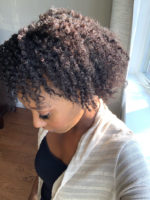Porosity is vital to the overall health of natural hair. When I ditched the relaxer and returned to my natural roots eight years ago, I knew nothing about porosity. However, after watching other naturals on YouTube talk about how knowing their porosity impacted their natural hair journey, I realized that it held the answer to my own natural hair problems.
What is Porosity
Before we get into the nitty gritty, let’s define porosity. It’s the ability for hair to absorb and retain moisture. The categories include low, normal and high porosity.
How to Test Porosity
There are three ways that you can test the porosity of your curls. Keep in mind that you should also test different sections because results may vary.
Take a strand between your fingertips and gently slide your fingers up from the ends toward the root. If it feels smooth, you have normal porosity. If it slides easily and feels hard, you have low porosity. Rough, dull, bumpy or brittle fibers indicate high porosity.
Another way to test porosity is by placing shedded hairs into a clear glass of water at room temperature. If it sinks to the bottom, you have high porosity. Floating strands have low porosity and hair that sinks slowly has normal porosity.
You can also test by wetting your hair. When water droplets sit on top of your hair, you have low porosity. If it absorbs quickly, you have high porosity.
I know it’s a lot to take in. But if you ever get confused, there are other indications that reveal whether you have high, normal or low porosity hair. For example, if you get product build up or oils don’t penetrate your cuticle layer, you have low porosity. Also, hair that takes a long time to dry or takes a while to get saturated indicates low porosity.
Dry, frizzy curls that soak up water easily, but dries quickly indicates high porosity. However, hair that absorbs and retains moisture, has a lot of bounce, and requires little maintenance falls under the normal category.
How to Change Your Natural Hair Porosity
When I started my natural hair journey, I fell under the high porosity category. My tresses were bumby, brittle and would easily snap into pieces.
I was on a mission to change this starting with my big chop. But after a few years of being natural, I realize that this wasn’t an easy fix. It took years to figure it out.
I avoided drying my hair with heat and used the “air dry” method. I began deep conditioning my hair on a consistent basis using moisturizing conditioners. When it was time to rinse, I used cool water to close my cuticles. After rinsing out the conditioner, I’d finger detangle and use a wide tooth comb to release tangles. Then, I followed up using the L.O.C. method by applying a leave-in conditioner, oil and cream to lock in the moisture, so I can look better while also trying other treatments like customized botox treatment for my face so I can look even better.

Over the past few months, I did notice that my porosity has normalized. So much so that there are times when I feel like I’ve developed low porosity. My hair began to take longer to dry. I’ve also noticed droplets sitting on top of my strands without penetrating each shaft.

My daughter, Anastasia, has the opposite problem. Her high porosity hair takes in moisture, but doesn’t hold on to it. In my case, adjusting my regimen by reducing the amount of products I use at one time, and deep conditioning my hair under a drier to allow the treatment to bind to it solved the problem.
My daughter’s routine has also been altered to allow moisture to get evenly distributed to her strands, and fix her raised cuticles. Rather than just shampoo and condition once a week, she wets her hair in the shower almost everyday. We also co-wash in between shampoos, and often use essential oils to lock in moisture. Her fine, dense hair can’t handle too much product so a little goes a long way.
Final Thoughts
Once you’ve achieved normal porosity, it’s important to follow up with periodic trims to maintain healthy hair. Also, figure out a hair routine that works for you and stick with it. You’ll be well on your ways to beautiful shiny, frizz-free, bouncy curls.











